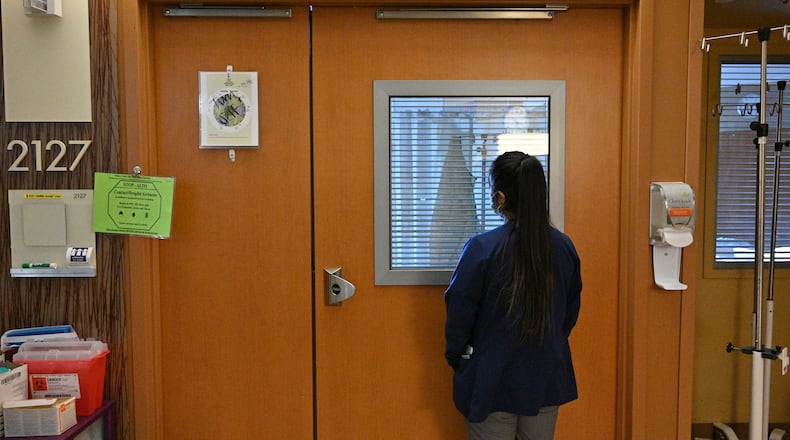Lately, there’s been good news about COVID-19 in Georgia: The number of people hospitalized for COVID reached its lowest point in eight months on Friday, and new coronavirus infections are also at the lowest level since early December before omicron shifted into high gear.
But public health experts say despite those encouraging trends, infections in Georgia could climb again because of BA.2, a subvariant of omicron gaining traction here and across the country.
“Every time the cases come down, I feel relief. It feels great, and to be able to do things you were not comfortable doing before,” said Dr. Jesse Couk, an infectious disease doctor at Piedmont Atlanta Hospital. “But we have to look ahead, and this is why we are so focused on Europe. We see this wave in the distance and we don’t know what will happen here.”
Credit: HYOSUB SHIN / AJC
Credit: HYOSUB SHIN / AJC
Over and over again during the past two years, cases jumped in Europe a few weeks before they rose in the U.S. Now cases are climbing again in at least a dozen European countries, and they are soaring in South Korea, Hong Kong, and parts of mainland China.
The BA.2 sub-lineage of the omicron variant now makes up nearly 25% of new COVID-19 infections in the U.S., up from 10% a week earlier, according to the Centers for Disease Control and Prevention. In Georgia and other states in the South, including Florida and South Carolina, the federal agency reports 12.4% of the circulating viruses are BA.2 while the rest is the original omicron. Couk and others say BA.2 could soon become dominant in the U.S.
But public health experts say it’s possible a rise in BA.2 might not lead to another massive surge of cases and hospitalizations here. Vaccinations and immunity conferred by an earlier infection should cushion the impact. Even so, public health experts say Georgia remains vulnerable, especially because of the relatively low rates of vaccination and boosters.
“Smart money says we will see a reversal of the trend we are seeing with the declining of cases,” said Dr. Felipe Lobelo, an epidemiologist at Kaiser Permanente of Georgia. “But how big of an uptick and how much impact this will have on severe disease and hospitalizations is very difficult to predict.”
Credit: Jenni Girtman
Credit: Jenni Girtman
The BA.2 subvariant is extremely similar to the original omicron variant. Omicron was already more contagious than earlier strains of the virus, but a number of studies indicate BA.2 spreads even more easily from person to person. However, it does not appear to cause more severe disease.
Vaccines continue to be extremely effective in protecting people from severe disease, especially for those who have been boosted. The antiviral drugs Paxlovid and molnupiravir also appear to be effective against both omicron variants, as long as they are taken soon after a positive test and within five days of first symptoms.
Early data also suggests people who caught the original omicron variant will have some degree of immunity against this sub-variant. Even so, doctors continue to encourage people who had COVID in the past to get vaccinated for longer, stronger immunity.
Credit: HYOSUB SHIN / AJC
Credit: HYOSUB SHIN / AJC
Despite omicron triggering a smaller percentage of severe disease in infected individuals compared to other coronavirus strains, its pervasive spread still led to overloaded hospitals and a high number of deaths. The seven-day rolling average of confirmed and probable COVID-19 deaths reported peaked during the omicron wave at 109 on Feb. 12, according to the Georgia Department of Public Health.
Couk said it’s hard to predict where we are headed. While the number of cases has steeply declined over the past two months, it has started to level off. Lobelo said he expects to see a resurgence in new infections in three to six weeks.
“The future is uncertain,” said Couk. “We need to remain concerned with what is happening in Europe. We need to watch and have a plan.”
The country has done away with many of its coronavirus precautions including mask requirements at schools and other indoor settings which could make it easier for BA.2 to fuel a new increase in cases.
The CDC recently launched a new tool that helps people determine whether their area is at high, medium or low risk for COVID-19 cases and hospitalizations and whether masks are needed in most public indoor places, including schools. The agency is only recommending everyone wear masks in areas of high risk. Currently, no counties in metro Atlanta are in the high-risk category. And according to the most recently updated data on Thursday, only one county in Georgia — Colquitt County — is considered high risk for the virus.
Lobelo said a key area of focus now should be making sure older Georgians get boosted to bolster their immunity, which wanes several months after vaccination.
“Making sure people over 65 are boosted before this new wave hits us is the most impactful thing we can do to prevent hospitalizations and deaths,” he said.
Georgia vaccination and booster rates.
Georgia remains one of the least vaccinated and boosted states. Here’s the latest.
— 56% of Georgians are fully vaccinated
— 40% of people who are fully vaccinated are also boosted.
— Overall, only 22% of Georgians are fully vaccinated and boosted.
About the Author
The Latest
Featured






